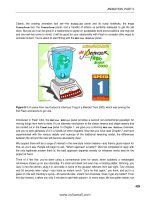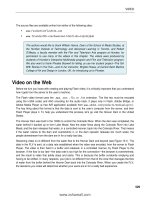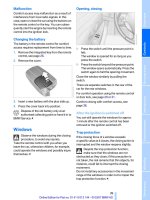Tài liệu Nurse’s Toolbook for Promoting Wellness docx
Bạn đang xem bản rút gọn của tài liệu. Xem và tải ngay bản đầy đủ của tài liệu tại đây (7.13 MB, 537 trang )
Nurse’s Toolbook
for
Promoting
Wellness
Notice
Medicine is an ever-changing science. As new research and clinical experience
broaden our knowledge, changes in treatment and drug therapy are required.The
authors and the publisher of this work have checked with sources believed to be
reliable in their efforts to provide information that is complete and generally in
accord with the standards accepted at the time of publication. However, in view
of the possibility of human error or changes in medical sciences, neither the
authors nor the publisher nor any other party who has been involved in the prepa-
ration or publication of this work warrants that the information contained herein
is in every respect accurate or complete, and they disclaim all responsibility for
any errors or omissions or for the results obtained from use of the information
contained in this work. Readers are encouraged to confirm the information con-
tained herein with other sources. For example and in particular, readers are
advised to check the product information sheet included in the package of each
drug they plan to administer to be certain that the information contained in this
work is accurate and that changes have not been made in the recommended dose
or in the contraindications for administration.This recommendation is of particu-
lar importance in connection with new or infrequently used drugs.
Nurse’s Toolbook
for
Promoting
Wellness
Carol A. Miller, MSN, RN-BC, AHN-BC
Clinical Nurse Specialist
Care & Counseling
Cleveland, Ohio
Clinical Faculty
Frances Payne Bolton School of Nursing
Case Western Reserve University
Cleveland, Ohio
New York Chicago San Francisco Lisbon London Madrid Mexico City
New Delhi San Juan Seoul Singapore Sydney Toronto
Copyright © 2008 by The McGraw-Hill Companies, Inc. All rights reserved. Manufactured in the United
States of America. Except as permitted under the United States Copyright Act of 1976, no part of this
publication may be reproduced or distributed in any form or by any means, or stored in a database or retrieval
system, without the prior written permission of the publisher.
0-07-159380-2
The material in this eBook also appears in the print version of this title: 0-07-147761-6.
All trademarks are trademarks of their respective owners. Rather than put a trademark symbol after every
occurrence of a trademarked name, we use names in an editorial fashion only, and to the benefit of the trade-
mark owner, with no intention of infringement of the trademark. Where such designations appear in this
book, they have been printed with initial caps.
McGraw-Hill eBooks are available at special quantity discounts to use as premiums and sales promotions,
or for use in corporate training programs. For more information, please contact George Hoare, Special Sales,
at or (212) 904-4069.
TERMS OF USE
This is a copyrighted work and The McGraw-Hill Companies, Inc. (“McGraw-Hill”) and its licensors reserve
all rights in and to the work. Use of this work is subject to these terms. Except as permitted under the
Copyright Act of 1976 and the right to store and retrieve one copy of the work, you may not decompile,
disassemble, reverse engineer, reproduce, modify, create derivative works based upon, transmit, distribute,
disseminate, sell, publish or sublicense the work or any part of it without McGraw-Hill’s prior consent. You
may use the work for your own noncommercial and personal use; any other use of the work is strictly
prohibited. Your right to use the work may be terminated if you fail to comply with these terms.
THE WORK IS PROVIDED “AS IS.” McGRAW-HILL AND ITS LICENSORS MAKE NO
GUARANTEES OR WARRANTIES AS TO THE ACCURACY, ADEQUACY OR COMPLETENESS OF
OR RESULTS TO BE OBTAINED FROM USING THE WORK, INCLUDING ANY INFORMATION
THAT CAN BE ACCESSED THROUGH THE WORK VIA HYPERLINK OR OTHERWISE, AND
EXPRESSLY DISCLAIM ANY WARRANTY, EXPRESS OR IMPLIED, INCLUDING BUT NOT
LIMITED TO IMPLIED WARRANTIES OF MERCHANTABILITY OR FITNESS FOR A PARTICU-
LAR PURPOSE. McGraw-Hill and its licensors do not warrant or guarantee that the functions contained in
the work will meet your requirements or that its operation will be uninterrupted or error free. Neither
McGraw-Hill nor its licensors shall be liable to you or anyone else for any inaccuracy, error or omission,
regardless of cause, in the work or for any damages resulting therefrom. McGraw-Hill has no responsibility
for the content of any information accessed through the work. Under no circumstances shall McGraw-Hill
and/or its licensors be liable for any indirect, incidental, special, punitive, consequential or similar damages
that result from the use of or inability to use the work, even if any of them has been advised of the
possibility of such damages. This limitation of liability shall apply to any claim or cause whatsoever whether
such claim or cause arises in contract, tort or otherwise.
DOI: 10.1036/0071477616
We hope you enjoy this
McGraw-Hill eBook! If
you’d like more information about this book,
its author, or related books and websites,
please click here.
Professional
Want to learn more?
To my family—with love and endless appreciation
for the countless ways in which they promote wellness in my life.
This page intentionally left blank
vii
Contents
Contributors. . . . . . . . . . . . . . . . . . . . . . . . . . . . . . . . . . . . . . . . . . . . . ix
Reviewers . . . . . . . . . . . . . . . . . . . . . . . . . . . . . . . . . . . . . . . . . . . . . . xi
Preface . . . . . . . . . . . . . . . . . . . . . . . . . . . . . . . . . . . . . . . . . . . . . . . xiii
Index of Wellness Teaching and Activity Tools . . . . . . . . . . . . . . . . . . . . . . . xv
PART I: OVERVIEW OF WELLNESS NURSING . . . . . . . . . . . . .1
Chapter 1 Exploring the Wellness Territory . . . . . . . . . . . . . . . . . . . . . . .3
Chapter 2 Fitting Wellness into Practice . . . . . . . . . . . . . . . . . . . . . . . .23
Chapter 3 Fine Tuning Our Wellness Skills . . . . . . . . . . . . . . . . . . . . . .52
PART II: PROMOTING PATIENTS’ WELLNESS
IN THEIR DAILY LIVES . . . . . . . . . . . . . . . . . . . . . . . . .89
Chapter 4 Promoting Wellness-Enhancing Actions . . . . . . . . . . . . . . . .91
Chapter 5 Teaching Patients to Protect Their Health . . . . . . . . . . . . .113
Chapter 6 Teaching Patients to Manage Stress . . . . . . . . . . . . . . . . . .135
Chapter 7 Promoting Spiritual Wellness . . . . . . . . . . . . . . . . . . . . . . .167
Chapter 8 Overview of Complementary and Alternative Medicine . . . .197
Chapter 9 Promoting Responsible Decisions about Biologically
Based Therapies . . . . . . . . . . . . . . . . . . . . . . . . . . . . . . . .227
PART III: PROMOTING SPECIFIC ASPECTS OF
PATIENTS’ WELLNESS . . . . . . . . . . . . . . . . . . . . . . . .253
Chapter 10 Nutritional Wellness . . . . . . . . . . . . . . . . . . . . . . . . . . . . .255
Chapter 11 Digestive Wellness . . . . . . . . . . . . . . . . . . . . . . . . . . . . . . .279
Chapter 12 Musculoskeletal Wellness . . . . . . . . . . . . . . . . . . . . . . . . .303
Chapter 13 Sensory Wellness . . . . . . . . . . . . . . . . . . . . . . . . . . . . . . . .329
Chapter 14 Breathing Well . . . . . . . . . . . . . . . . . . . . . . . . . . . . . . . . . .364
Chapter 15 Cardiovascular Wellness . . . . . . . . . . . . . . . . . . . . . . . . . . .396
Chapter 16 Urinary Wellness . . . . . . . . . . . . . . . . . . . . . . . . . . . . . . . .412
Chapter 17 Sleeping Well . . . . . . . . . . . . . . . . . . . . . . . . . . . . . . . . . . .447
Chapter 18 Sexual Wellness . . . . . . . . . . . . . . . . . . . . . . . . . . . . . . . . .482
Appendix . . . . . . . . . . . . . . . . . . . . . . . . . . . . . . . . . . . . . . . . . . . . . 499
List of Assessment Tools . . . . . . . . . . . . . . . . . . . . . . . . . . . . . . . . 499
List of Terminology Boxes . . . . . . . . . . . . . . . . . . . . . . . . . . . . . . . 501
List of Clinical Resource Boxes. . . . . . . . . . . . . . . . . . . . . . . . . . . . 502
Index . . . . . . . . . . . . . . . . . . . . . . . . . . . . . . . . . . . . . . . . . . . . . . . . 503
For more information about this title, click here
This page intentionally left blank
ix
Contributors
Anita White, MSN, RN, CCRN
Critical Care Nurse Educator, Elyria Memorial Hospital, Elyria, Ohio
Cardiovascular Wellness: Chapter 15
Jill Bormann, PhD, RN
Research Nurse Scientist,Veterans Administration San Diego Healthcare System
A Nurse’s Perspective: A Quick and Easy Stress Reduction Method for Self-Care,
Chapter 6
Wellness Activity Tool 6.1: Frequent Mantram Repetition
Cheryle B. Gartley
President and Founder,The Simon Foundation for Continence
Patient’s Perspectives, Chapter 16
Sister Corinne Lemmer, PhD, RN
Mount Marty College,Yankton, South Dakota
Nurse’s Experiences, Chapter 7
Kathleen Lindell, RN, MS
Doctoral Student, University of Pittsburgh School of Nursing
Resource Box: Case Example of Nursing Interventions for Smoking Cessation,
Chapter 14
Janice E. McGrogan, Spiritual Care Coordinator
Hospice of the Western Reserve, Cleveland, Ohio
Another Perspective on How Nurses Provide Spiritual Care, Chapter 7
A Perspective on Caring for Patients During Times of Suffering, Chapter 7
Nursing Staff
Memorial Medical Center, Springfield, Illinois
Resource Box: Example of a Hospital Protocol for Promoting Sleep Wellness,
Chapter 17
Nursing Staff
St. Charles Medical Center, Bend, Oregon
Resource Box: Application of the Caring Model in a Hospital Setting, Chapter 3
Resource Box: Hospital Protocol for Praying with Patients, Chapter 7
Belleruth Naparstek, LISW, BCD
Psychotherapist, Author, Guided Imagery Expert
Wellness Teaching Tool 4.2: How to Do Guided Imagery with Patients in a Few
Minutes
Wellness Activity Tool 4.1: Using Affirmations for Promoting Health
Barbara Kammerer Quayle
Patient’s Perspectives, Chapter 3
Copyright © 2008 by The McGraw-Hill Companies, Inc. Click here for terms of use.
x
•
Contributors
Kevin Smith, MSN, RN, CNP
Adjunct Faculty, University of Minnesota School of Nursing and Center for Spirituality and
Healing
Perspective of a Nurse Expert on Humor as a Communication Tool, Chapter 6
Marsha Jelonek Walker, PhD, RN, AHN-BC, LMT
Private Practice, Stress Management Consultant
Resource Box: The HeartTouch Technique, Chapter 6
Tina Weitzel, MA, BSN, RNC
Nursing Quality Specialist, Memorial Medical Center, Springfield, Illinois
A Nurse’s Perspective on Promoting a Cultural Norm of Quiet, Chapter 17
A Nurse’s Perspective: The Sh-h-h-h!!! Project, Chapter 17
ACKNOWLEDGMENTS
In addition to the nurses, patients, and experts who are listed, I extend a special
acknowledgment to the people who shared their perspectives and are identified
by pseudonyms as Graham, Nancy, Marge, and Mary Patricia. Their valuable
insights about their experiences can help nurses respond more sensitively as we
promote wellness for our patients. I also appreciate the valuable contribution of
Dr. Elizabeth Click and nursing students in her health promotion class at
Frances Payne Bolton School of Nursing, Case Western Reserve University.
I am deeply grateful for the advice, assistance, and expertise of the outstand-
ing people at McGraw-Hill. In particular, Quincy McDonald, Senior Editor, has
shared the vision of developing a clinical reference toolbook to help nurses
quickly and easily promote wellness for their patients. Quincy has steadfastly
supported this text since its inception and his expert guidance has been essen-
tial for bringing it to fruition.
On a very personal level, I acknowledge and deeply appreciate the support
from my family and friends through all the challenges of developing this book.
In particular, I am grateful for the never-ending support and encouragement
from Pat Rehm, who is at the top of my list of the many significant people who
promote my wellness.
Copyright © 2008 by The McGraw-Hill Companies, Inc. Click here for terms of use.
xi
Reviewers
H. Lea Barbato Gaydos, PhD, RN, CS, AHN-BC
Associate Professor
University of Colorado
Colorado Springs
Beth-El College of Nursing and Health Sciences
Colorado Springs, Colorado
Mary Knudtson, DNSc, MSN, FNP, PNP
Professor of Family Medicine
Director of FNP Program
University of California, Irvine
Irvine, California
Juanita Manning-Walsh, PhD, RN
Associate Professor
Western Michigan University
Bronson School of Nursing
Kalamazoo, Michigan
Mary Anne Osborne Schwenka, BSN, MS
Family Nurse Practitioner
Woodland Integrative Medicine
Woodland Park, Colorado
Jacqueline L. Wylie, RN, MSN, MA
Retired Nurse Educator
Western Michigan University
Bronson School of Nursing
Kalamazoo, Michigan
Copyright © 2008 by The McGraw-Hill Companies, Inc. Click here for terms of use.
This page intentionally left blank
xiii
Preface
A Nurse’s Reflections on Promoting Wellness
When I reflect on my roles as a nurse, I identify my “raison d’ être´”—my most
fundamental reason for being a nurse—as caring about my patients and pro-
moting their wellness. I think about the many ways in which I use my nursing
skills to help bring new life into this world; facilitate healing of body, mind, and
spirit; and provide comfort during times of illness and death.Then my thoughts
focus on the challenge of reconciling my ideals of having time to provide holistic
care with the harsh realities inherent in the hurry and scurry of my job. These
thoughts lead to questions about how I can quickly and easily incorporate well-
ness into my usual care. I even begin to wonder if I ever really “do” wellness nurs-
ing when I care for patients—then I reflect on the many simple ways in which I
use my nursing skills to provide holistic care. For example, when I was assigned
to take care of Mrs. M., I made a conscious effort to promote her wellness, even
though other nurses had warned me that she was likely to complain loudly about
anything I tried to do for her. Before beginning my care I took a moment to cen-
ter myself, then I entered her room, looked straight into her eyes, and caringly
said “Good morning, Mrs. M., my name is Carol and I’ll be caring for you
today. I understand things have been quite difficult for you and I’m hoping you’ll
share your concerns with me so we can find ways of making you more comfort-
able.”After attending to her physical needs, I offered to teach her a simple breath-
ing technique that she could use to reduce stress and she was most receptive to
this. It took only a few minutes to empower Mrs. M. toward a sense of personal
responsibility for her wellness and I gained the satisfaction of knowing that I had
addressed more than her physical needs. Sometimes I hear tangible rewards for
my efforts to promote wellness for my patients, as when a patient recently told me
“I can tell that you really care about me.”
Purpose and Overview
The foundation for this clinical reference is my belief that all people aspire to
have wellness—which I define simply as “I’m OK and I want to be better”—and
that nurses have numerous opportunities to promote wellness by using our skills
to communicate to each patient that “You’re OK and I can help you be better.”
Although promoting wellness is an ideal, nurses often feel that they don’t have
time for tasks that are superimposed upon the already overwhelming demands
that bombard them from many directions. A basic premise of this book is that
nurses can quickly, readily, and routinely provide wellness-oriented care in clin-
ical settings by using the wellness assessment, teaching, and activity tools in this
book to develop a “wellness way of thinking” and improve patient care. I devel-
oped these tools based on both the successful experiences of nurses and the rap-
idly increasing body of knowledge related to many aspects of wellness. Chapter 1
Copyright © 2008 by The McGraw-Hill Companies, Inc. Click here for terms of use.
xiv
•
Preface
provides details about content and organization as well as tools and other
unique features that are incorporated throughout this book.
Guide to Using Tools in Clinical Settings
This book contains three types of tools that nurses can copy for use in clinical
settings to facilitate wellness-oriented care. The intent of the Wellness Assessment
Tools is to help nurses focus on a specific aspect of functioning from a broad and
holistic perspective. Nurses can copy these tools, which are listed in the
Appendix, to use as stand-alone documents or they can incorporate relevant
points in their usual assessments. The intent of Wellness Teaching Tools and
Wellness Activity Tools is to provide easy-to-use guides for enhancing wellness-
oriented nursing skills or teaching patients about specific aspects of wellness, as
delineated in the following index.
xv
Index of Wellness Teaching and
Activity Tools
To fine tune wellness-oriented Use Wellness Teaching or
nursing skills related to . . . Activity Tool . . .
…being present to patients …3.1 (p. 57)
…empowering patients …3.2 (p. 61)
…enhancing cultural sensitivity …3.3 (p. 65)
…teaching patients about healthy …4.1 (p. 99)
behaviors
…doing guided imagery with patients …4.2 (p. 103)
in a few minutes
…using humor in nursing …6.2 (p. 158)
…addressing patients’ spiritual needs …7.2 (p. 187)
…learning about culturally based …8.1 (p. 203), 8.2 (p. 204),
health practices 8.3 (p. 206), 8.4 (p. 207)
…regulation of dietary supplements …9.1 (p. 231)
…talking with patients about weight …11.2 (p. 295)
management
…communicating with patients who …13.2 (p. 346)
are hard of hearing
…addressing sexual concerns of patients …teaching tools 18.1 (p. 486),
18.2 (p. 488), & 18.3 (p. 490);
activity tool 18.1 (p. 496)
Copyright © 2008 by The McGraw-Hill Companies, Inc. Click here for terms of use.
xvi
•
Index of Wellness Teaching and Activity Tools
To promote wellness by Give them Wellness
teaching patients about . . . Teaching Tool . . .
…health protection …5.1. & 5.5 for all adults
(pp. 115 & 130), 5.2 for
men (p. 118), and 5.3 for
women ( p. 120)
…adult immunizations …5.4 (p. 126)
…stress management …6.1 (p. 151)
…spiritual growth …7.1 (p. 184)
…Complementary and Alternative …8.5 (p. 218), 8.6 (p. 219),
Medicine (CAM) 8.7 (p. 221), 9.5 (p. 246),
& 9.6 (p. 249)
… herbs and other dietary supplements …9.2 (p. 241), 9.3 (p. 242),
& 9.4 (p. 245)
… healthy food selection …10.1 (p. 258), 10.2 (p. 260),
10.3 (p. 261)
…nutrition and exercise …10.4 (p. 263)
…digestive wellness …11.1 (p. 292)
…physical activity …12.1 (p. 317)
…musculoskeletal wellness …12.2 (p. 318)
…hearing wellness …13.1 (p. 336), 13.3 (p. 347)
…respiratory wellness …14.1 (p. 379) & 14.2 (p. 381)
…quitting smoking …14.3 (p. 384)
…cardiovascular wellness …15.1 (p. 406)
…urinary wellness …16.1 (p. 434), 16.2 (p. 437)
…sleep wellness …17.1 (p. 467), 17.2 (p. 469),
17.3 (p. 471)
Index of Wellness Teaching and Activity Tools
•
xvii
To promote personal responsibility
by helping patients find sources Give them Wellness
of reliable information about . . . Teaching Tool . . .
…health promotion …4.3 (p. 106)
…herbs and other dietary supplements …9.4 (p. 245)
…nutrition …10.5 (p. 275)
…weight management …11.3 (p. 297)
…musculoskeletal wellness …12.3 (p. 320)
…hearing …13.4 (p. 348)
…vision …13.6 (p. 360)
…respiratory wellness …14.4 (p. 385)
…cardiovascular wellness …15.2 (p. 407)
…bladder health …16.3 (p. 438)
…sleep …17.4 (p. 472)
…sexual wellness …18.4 (p. 493)
xviii
•
Index of Wellness Teaching and Activity Tools
Give Them Wellness
To help patients learn to . . . Activity Tool . . .
…recognize the influence of their …1.1 (p. 21)
relationships on their wellness
…listen to their body messages …2.1 (p. 38)
…use breathing techniques for stress …2.2 (p. 41), 14.1 (p. 389),
reduction, wellness, and improved sleep 17.1 (p. 476)
…use affirmations for improved health …2.3 (p. 43) & 4.1 (p. 104)
…use frequent mantram repetition to …6.1 (p. 148)
reduce stress
…use meditation as a mind-body …6.2 (p. 154)
intervention
…use pelvic muscle exercises for better …16.1 (p. 442)
urinary control
PART I
Overview of
Wellness Nursing
Chapter 1 Exploring the Wellness Territory
Chapter 2 Fitting Wellness into Practice
Chapter 3 Fine Tuning Our Wellness Skills
Copyright © 2008 by The McGraw-Hill Companies, Inc. Click here for terms of use.
This page intentionally left blank
CHAPTER 1
Exploring the Wellness
Territory
BEGINNING THE WELLNESS JOURNEY
A Nurse’s Reflections on Wellness
Chapter Overview
The Itinerary for the Wellness Journey
Guide to Using This Book
EXPLORING THE “WHAT” OF WELLNESS
A Nurse’s Reflections on Exploring Wellness
Discovering the “What” of Wellness
ACHIEVING BALANCE THROUGH ALL PHASES OF HEALTH
A Nurse’s Reflections on the “When” of Wellness
Wellness During All Times
Bob’s Wellness Story
INTEGRATING BODY, MIND, AND SPIRIT
A Nurse’s Reflections on Body, Mind, and Spirit
Integrating Body, Mind, and Spirit in Health Care
Nursing Perspectives on Body–Mind–Spirit Interrelatedness
PROMOTING PERSONAL RESPONSIBILITY
A Nurse’s Reflections on Promoting Personal Responsibility
Personal Responsibility as the Foundation of Wellness
Identifying Interventions to Support Personal Responsibility
Engaging in Wellness Actions
Ann’s Wellness Story
RELATIONSHIPS WITH SELF AND OTHERS
A Nurse’s Reflections on Relationships
Nursing Responsibilities for Relationships with Self and Others
RELATIONSHIPS WITH THE ENVIRONMENT
A Nurse’s Reflections on Environments of Care
Nursing Responsibilities for Environments of Care
CHAPTER HIGHLIGHTS
POINTS FOR PONDERING AND PRACTICE
• Wellness Activity Tool 1.1: Self-Assessment of the Influence of My Relationships
on My Wellness
REFERENCES
3
Copyright © 2008 by The McGraw-Hill Companies, Inc. Click here for terms of use.
4
•
Nurse’s Toolbook for Promoting Wellness
BEGINNING THE WELLNESS JOURNEY
A Nurse’s Reflections on Wellness
I wonder a lot about wellness. I see the word everywhere—on buildings and cereal
boxes, in newspapers, brochures, and advertisements. It pops up on my screen
when I’m browsing the Internet. I overhear it in conversations; I talk about it
with my friends, family, patients. I even talk to myself about it. So I ask myself:
What is wellness? . . .When does it happen? . . .Where do I find it? . . . How can
I get my share of it? As I ponder these questions, I realize that wellness is a jour-
ney from being OK to being better. I believe that everyone wants wellness and
should be able to have it, so I need to learn about successfully navigating this
journey. Because I want to use my nursing skills to guide my patients on their
journeys, I’ve learned how to achieve wellness and help my patients travel toward
wellness. Because I like to share my discoveries, I’ve written this book about how
we as nurses navigate the path toward wellness and guide our patients on their
journeys.
Chapter Overview
Wellness is a journey that each of us takes in our quest for well-being of body,
mind, and spirit. Key components of wellness include personal responsibility,
balance through all phases of health, body–mind–spirit connectedness, and rela-
tionships with self, others, and the environment. As nurses, we guide our
patients on their wellness journeys, so we need to be familiar with the wellness
path and be progressing toward our own wellness. In addition, we need to pro-
vide maps for our patients so we can assist their discovery of wellness in their
lives. This chapter provides an itinerary for the rest of this book, which is filled
with tools that nurses can use as maps for our patients as well as ourselves.
The Itinerary for the Wellness Journey
Nurses clearly understand that we use the art and science of nursing to promote
wellness, but we are less clear about what wellness actually is. Even less evident
is how we can incorporate this idea of wellness into caring for our patients as we
work in environments that are wellness unfriendly. We also may be less clear
about how to promote self-wellness in our personal lives because we focus so
much on meeting the needs of others.
One mission of this book is to provide a succinct base of knowledge about
what wellness is and how nurses promote wellness in our nursing practice and
personal lives. A second mission is to provide a large base of practical tools that
show quickly and precisely how to practice wellness with the patients for whom
we care and for ourselves. Content is developed from the perspective of a nurse
who is committed to practicing and teaching wellness as a way of thinking and
living, so it draws on reflections and stories to illustrate application of concepts
and tools. Most importantly, this book provides a roadmap for nurses as we
Chapter 1: Exploring the Wellness Territory
•
5
travel our own wellness journeys and guide patients on their journeys to well-
ness. Because this itinerary chapter—like an armchair travel guide—outlines
what we expect to discover along the way, there are many references to other
chapters that contain more details about this journey.
Guide to Using This Book
Part I of the book discusses the what, when, how, and where of wellness.
Chapter 1 provides descriptive snapshots of our destinations, so we’ll be able to
recognize wellness when we see it. We’ll learn about when and how we experi-
ence and promote wellness, but won’t yet embark on the actual journey.
Chapter 2 is a “how-to” planning guide that focuses on skills that are essential
for fitting wellness into our patient care. We’ll visit the territory of the nursing
process and meet some patients who share their experiences about how nurses
have guided them on their wellness journeys. A nurse will accompany us
through this territory as we learn how to apply wellness concepts in our work
and in our personal lives. During this part of the journey, we’ll collect some tools
that we can use to incorporate wellness in our assessments.We’ll also collect some
great tools that we can give to our patients to promote their wellness. Chapter 3
is a guide to “packing our bags”; it will help us fine tune our wellness skills and
provides some tools that can be used to guide patients to wellness. We’ll learn
about wellness language so we can be more comfortable communicating with
our patients and teaching them about the wellness journey. We’ll also explore
aspects of cultural diversity that will be useful in our relationships with others.
By the time you have finished the chapters in Part I, your bags will be packed
and you will be prepared to guide patients to many wellness destinations.
The chapters in Part II focus on topics that are pertinent to patients’ wellness
in their daily lives, and this information is applicable to most patient care situa-
tions. Chapters 4 and 5 go hand in hand to review health-promotion interven-
tions from a holistic nursing perspective, with the emphasis on teaching patients to
engage in wellness-enhancing and health-protecting actions.Teaching tools in these
chapters are designed to help patients develop healthy behaviors as well as assume
responsibility for many aspects of preventive care. Chapters 6 and 7, which also
go hand in hand, address stress management and spiritual needs in clinical set-
tings. Assessment and teaching tools in Chapter 6 focus on stress management
methods that nurses can use for self-wellness or to help patients respond effec-
tively to stress. Nurses can use the assessment and teaching tools in Chapter 7 to
overcome some of the barriers to promoting spiritual wellness and address spiri-
tual distress for patients. Chapters 8 and 9 provide information about comple-
mentary and alternative medicine (CAM) practices, with a strong emphasis on
teaching patients how to make responsible decisions about these modalities.These
chapters contain many teaching tools about practices that are most relevant to
patient care and patient education. In addition, nurses can use the assessment and
teaching tools in Chapter 9 to identify and address concerns related to safety and
efficacy of herbs and other dietary supplements.









